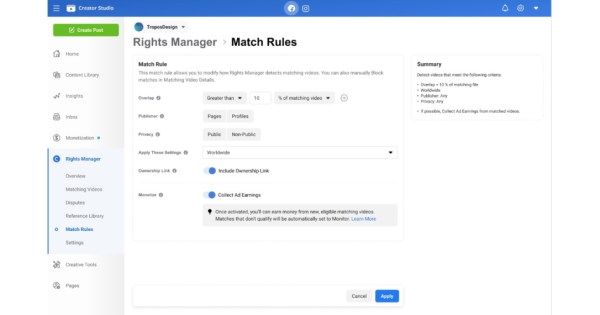Marketing campaigns that use search ads, social media, and content marketing can be costly—and it takes trial and error to figure out which ones are worth it.
But what if you only paid when an ad delivered actual sales? That’s the beauty of affiliate marketing, in which you partner with social media influencers, bloggers, or podcast hosts to promote your product. You create a unique link to your ecommerce store that the affiliate shares with their audience, and you pay a commission only when a customer clicks or buys.
“One of the best things about affiliate marketing is that it’s performance-based, so you’re not wasting money on ads that might not work,” says Cristy Garcia, chief marketing officer at impact.com, a leading partnership management platform. “It’s a cost-effective, low-risk way to bring in new customers. ”
Brands and affiliate marketers alike are reaping the benefits. By some measures, the affiliate marketing business drives 16% of ecommerce sales in the US and Canada. Here are the latest trends in the affiliate space that Cristy and other industry leaders are tracking.
Become a Shopify Affiliate
Join the program to grow your brand, access exclusive opportunities, and earn a competitive commission for each new business you refer to Shopify.
Apply now
Top affiliate marketing trends
The worldwide affiliate marketing industry is growing fast and is forecast to reach $15.7 billion by the end of 2024. With this growth comes change. Tracking the following key affiliate marketing trends can help your business stay ahead.
Customers are highly informed, but they’re more skeptical than ever
Multiple generations of buyers, including millennials and Gen Z, use the internet and social media to inform their shopping and purchase decisions.
“Today’s buyers are the most informed in history,” Cristy says. “They’re technologically savvy, regularly use various social media platforms, browse multiple websites, and are accustomed to consuming large amounts of content every day.”
Included in all that content? Lots of ads—so much that many people consider ads as little more than digital noise. Cristy says traditional ads have become ineffective, more expensive, and even annoying. Instead, many potential customers seek social proof and recommendations from trusted sources like content creators—which is why affiliate marketing strategies often works so well.
But ecommerce companies should take care in selecting their affiliate partners. The ideal affiliate is trusted by your target audience and feels like an authentic fit with your brand’s values and image.
For example, an influencer who sometimes shows off fast-fashion outfits that are discarded after a few uses may clash with the ethos of a brand focused on sustainability. Or imagine a financial podcast host who reads marketing materials for scuba gear. It’s not exactly a fit for their broad audience, and it’s highly likely the message just won’t land. Authenticity is paramount—a critical strategy from day one.
🌟Affiliate programs are growing fast. Learn how to set up an affiliate program for your store, step by step.
Affiliate marketing models are rapidly diversifying
The typical affiliate partners are content creators, influencers, and bloggers. But maybe you’d also like to work with community leaders, develop a mutually beneficial co-marketing strategy with another company, or simply try something that doesn’t allow for an embeddable link.
The good news is that your affiliate marketing budget is not just for digital marketing and you can partner with affiliates who don’t use digital platforms.
“The affiliate marketing landscape was once limited to specific platforms like email, social media, and blogs,” Cristy says. “But with technological advancements and a bit of creativity, anyone can become an affiliate, regardless of whether they have established media properties.”
For example, Cristy cites a company that sells dog treats and toys that wanted to expand its customer base by partnering with local animal shelters. People who adopted a dog from the shelters received a free box of treats from the company, and inside was a QR code that they could scan to sign up for a subscription box. The company gained new customers, and shelters earned a small commission from each conversion—a success that spurred brand partnerships with animal shelters in other locations.
You may also consider brand-to-brand partnerships with companies that offer complementary products or services. For example, a specialty cookware brand might team up for joint campaigns with a company that delivers chef-crafted meals to customers. Each brand could include cards in their deliveries with affiliate URLs to purchase items from the partner.
“This type of co-marketing has been effective for a long time because it leverages the power of two companies to reach a broader audience and drive engagement,” Cristy says.
The upshot: Get creative when brainstorming potential affiliate relationships. Don’t limit yourself to the influencer set, and think outside the digital box.
AI and other tools are fueling dynamic insights
As with traditional marketing efforts, you can track, tweak, and optimize affiliate marketing campaigns over time. New artificial intelligence (AI) tools are making this easier than ever. Consider partnering with management platforms that offer these advanced features to inform your strategic approach.
For example, Cristy says AI can automate much of the deep work of vetting affiliate partners. AI tools can perform searches across the online world to identify the right partners for your brand, including checking the potential affiliate’s previous brand connections and activities to ensure they align.
Cristy’s firm, Impact, worked with small-appliance maker SharkNinja, which leveraged several of these affiliate marketing software features, among others, to expand its affiliate program. As a result, Cristy says, more than 900 new partners signed up with SharkNinja, generating a 30% quarter-over-quarter increase in affiliate revenue.
Affiliate marketing and influencer marketing are converging
These terms are used somewhat interchangeably, but affiliate and influencer marketing have historically been two discrete channels.
“Traditionally, influencer marketing has been seen as a top-of-funnel strategy focused on raising awareness and introducing new products,” says Cristy. “Affiliates are known for their expertise in driving conversions, often considered a bottom-of-funnel strategy, as they know how to promote products and attract ready-to-buy audiences.”
Over time, she says, these two channels have converged.
“Affiliates can also generate awareness, and influencers can drive sales,” Cristy says. “The true power lies in combining these two strategies to engage consumers at every point in the funnel.”
Vintage apparel company Homage did just that. It combined separate influencer and affiliate marketing programs on Impact’s platform. This consolidation, coupled with Impact’s advanced tracking and reporting tools, helped Homage enter new affiliate partnerships and customer markets. The result was a 485% return on investment.
Find influencers to drive sales with Shopify Collabs
Shopify Collabs makes it easy to partner with creators, promote your products, reach new customers, grow your sales, and track affiliate performance all from Shopify admin.
Affiliate marketing trends FAQ
Is affiliate marketing trending?
What is the future of affiliate marketing?
The affiliate industry is growing rapidly as more consumers seek social proof and credibility. The affiliate arena is seeing the convergence of influencer and affiliate networks. AI tools are automating many parts of the process and providing valuable insights, including identifying new potential partners and vetting their past content to ensure they’re a fit for your brand.
Why is affiliate marketing important for ecommerce?
An affiliate marketing strategy is cost effective and lower risk compared to traditional marketing. Also, affiliates and influencers give your brand exposure to new audiences and markets while also lending you the trust, credibility, and goodwill they’ve built with their followers.












